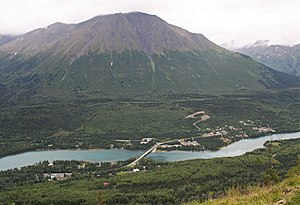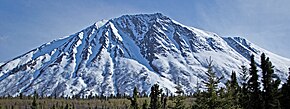Cecil Rhode Mountain
Topic: Earth
 From HandWiki - Reading time: 2 min
From HandWiki - Reading time: 2 min
| Cecil Rhode Mountain | |
|---|---|
 North aspect, from Slaughter Ridge (Cooper Landing and Kenai Lake below) | |
| Highest point | |
| Elevation | 4,400 ft (1,300 m) [1] |
| Prominence | 50 ft (15 m) [2] |
| Isolation | 0.33 mi (0.53 km) [1] |
| Coordinates | [ ⚑ ] : 60°27′58″N 149°49′09″W / 60.46611°N 149.81917°W [3] |
| Naming | |
| Etymology | Cecil E. Rhode |
| Geography | |
| Location | Chugach National Forest Kenai Peninsula Borough Alaska, United States |
| Parent range | Kenai Mountains |
| Topo map | USGS Seward B-8 |
Cecil Rhode Mountain is a 4,400-foot (1,341 m) mountain summit located in the Kenai Mountains, on the Kenai Peninsula in the state of Alaska. The mountain is situated in Chugach National Forest, 50 mi (80 km) south of Anchorage, and 1.7 mi (3 km) south of Cooper Landing, Alaska. This peak is shown on maps as Cooper Benchmark, the northernmost peak on a ridge which includes Stetson Benchmark (4,576-ft), and Peak 4593.[4] The mountain was named for Cecil E. Rhode (1902–1979), director of the Izaak Walton League, wildlife photographer, and writer who lived in Cooper Landing for 42 years and was best known for bringing wide exposure to the public about the wilds of Alaska, particularly in magazines such as National Geographic, Sports Afield, and Outdoor Life.[3] The mountain's toponym was officially adopted August 13, 1981, by the United States Board on Geographic Names. Precipitation runoff from the mountain drains into the Kenai River.
Climate
Based on the Köppen climate classification, Cecil Rhode Mountain is located in a subarctic climate zone with long, cold, snowy winters, and mild summers.[5] Winter temperatures can drop below −20 °C with wind chill factors below −30 °C. This climate supports a spruce and hemlock forest on the lower slopes.
See also
- List of mountain peaks of Alaska
- Geology of Alaska
References
- ↑ 1.0 1.1 "Cecil Rhode Mountain, Alaska". http://www.peakbagger.com/peak.aspx?pid=23985.
- ↑ Cecil Rhode Mountain AK listsofjohn.com
- ↑ 3.0 3.1 "Cecil Rhode Mountain". United States Geological Survey. https://geonames.usgs.gov/apex/f?p=gnispq:3:::NO::P3_FID:1415996.
- ↑ "Peak 4593, Alaska". http://www.peakbagger.com/peak.aspx?pid=87475.
- ↑ Peel, M. C.; Finlayson, B. L.; McMahon, T. A. (2007). "Updated world map of the Köppen−Geiger climate classification". Hydrol. Earth Syst. Sci. 11. ISSN 1027-5606.
External links
- Cecil Rhode Mountain Weather forecast
- Flickr photo
- Flickr photo
 |
 KSF
KSF

